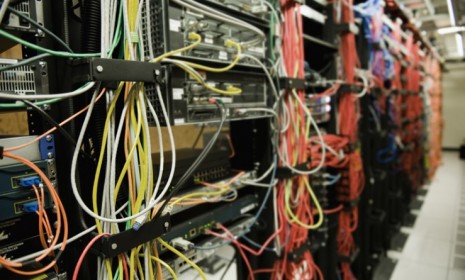The furnace of the future: Computer servers?
Computer data centers are energy-hogs that generate a ton of heat. Why not take advantage of that warmth, say researchers

As we do more and more of our computing online and in the cloud, we're requiring more and more server space to keep our Netflix streaming and our iPhones' Siri assistants obeying our every command. As a result, computer data centers are increasingly gobbling energy — both to keep them powered up, and to keep them cool. Some researchers have proposed an interesting scheme to take advantage of all the warmth that servers generate: Why not use it to heat people's homes? Here, a brief instant guide:
What is this computer-server heater?
Four researchers from Microsoft Research and two from the University of Virginia are working on a concept they call the "data furnace." Since computer servers create a great deal of heat, the idea would be for a home with a broadband connection to act as a "micro data center" for a company requiring computing power. Instead of a furnace, a cabinet filled with computer servers would be connected to a circulation fan and ductwork to heat the house.
The Week
Escape your echo chamber. Get the facts behind the news, plus analysis from multiple perspectives.

Sign up for The Week's Free Newsletters
From our morning news briefing to a weekly Good News Newsletter, get the best of The Week delivered directly to your inbox.
From our morning news briefing to a weekly Good News Newsletter, get the best of The Week delivered directly to your inbox.
How much energy do computer servers use?
A lot, raising fears of a looming "data center energy crisis." In September, Google revealed that its electricity usage equals that of 200,000 homes, and that its data centers continuously draw nearly 260 million watts, roughly equal to 25 percent of the output of a nuclear power plant. In 2010, data centers in the U.S. accounted for 1.7 to 2.2 percent of total electricity use according to one recent study. Greenpeace estimates that the figure is closer to 3 percent. Such statistics have tech companies actively seeking more efficient server setups.
What are tech companies doing to make server farms more energy efficient?
Facebook recently announced that it's building a server farm in northern Sweden, just 60 miles south of the Arctic Circle, that will rely almost exclusively on hydroelectric power and use the naturally cold air to cool servers. Google has a server farm in Finland that uses water from the Baltic Sea for cooling. Apple recently announced plans to build a solar farm next to its huge data center in North Carolina and switch from coal to solar power.
A free daily email with the biggest news stories of the day – and the best features from TheWeek.com
How much money could the home-based "data furnace" concept save companies?
Researchers estimate that 40 servers cost about $16,000 a year to run, including the cost of building brick-and-mortar server centers and keeping them cool. If the same servers were housed in a "data furnace" in a home, researchers say the cost would be less than $3,600 a year. "The company's data center could thus cover the homeowner's electricity costs for the servers and still come out way ahead financially," says Randall Stross in The New York Times.
What would happen in the summer when you don't want the heat on?
During the warm months, the heat generated by the servers would simply be directed outside, "as harmless as a clothes dryer's," though it's doubtful all home owners would want to add a new outdoor vent to their dwelling's exterior. Researchers say that if outside temps topped 95 degrees, servers would need to be temporarily shut down.
So, will there soon to be a data furnace in every home?
Not quite yet. Many aren't sure if this is "crazy idea" or a "stroke of genius." One obvious concern is security. "How could IT companies ensure that a client’s confidential data is safe in some random family’s basement? What about floods, power outages, or server snafus?" asks Rebecca Boyle at Popular Science. Researchers say the servers would remain under the control of a company's central data center and all data would be encrypted. If a server failed, its work would be automatically designated to another. "We've gotten a very strong response, more than I usually get after publishing a scientific paper," says one of the researchers. "We heard from several people who are already heating their homes with computer systems, which shows that it works."
Sources: ABC News, Analytics Press, CTOEdge, Guardian, New York Times (2), Popular Science
-
 7 bars with comforting cocktails and great hospitality
7 bars with comforting cocktails and great hospitalitythe week recommends Winter is a fine time for going out and drinking up
-
 7 recipes that meet you wherever you are during winter
7 recipes that meet you wherever you are during winterthe week recommends Low-key January and decadent holiday eating are all accounted for
-
 Nine best TV shows of the year
Nine best TV shows of the yearThe Week Recommends From Adolescence to Amandaland